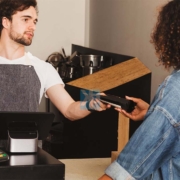Tomorrow’s Storefront: How Tech is Revolutionizing Retail
In the heart of every bustling retail store lies a story – a narrative woven by the interaction of shoppers and merchants, products and purchases. It’s a tale as old as commerce itself, yet one that’s constantly evolving with the advent of technology – retail tech. Imagine stepping into a store where the traditional concept of checkout lines has been replaced by a seamless, frictionless experience. As a small business owner, this isn’t just a dream; it’s the reality that tomorrow’s storefronts are embracing.
Enhanced Customer Experience Through Retail Tech
In this fast-paced digital age, customers crave more than just products; they seek experiences that resonate with them on a personal level. This is where technology plays a pivotal role in transforming the retail landscape. Consider the story of Emily, a boutique owner with a passion for fashion and a deep connection to her customers. By leveraging AI-driven analytics, Emily was able to understand her customers’ preferences and tailor her inventory accordingly. This not only led to an increase in sales but also created a loyal customer base that felt understood and valued.
AI-Powered Personalization
Implementing AI and machine learning algorithms can help small businesses like yours analyze customer data to offer personalized product recommendations.
By understanding your customers’ preferences and shopping behaviors, you can create a more engaging and targeted shopping experience.
AR/VR for Immersive Experiences
Augmented reality (AR) and virtual reality (VR) technologies offer innovative ways to enhance the shopping experience.
Imagine allowing your customers to virtually try on clothes or visualize how furniture would look in their homes. These immersive experiences not only captivate your audience but also drive sales by increasing confidence in purchase decisions.
Customer Experience Questions to Consider
- How can you use AI to personalize the shopping experience for your customers?
- What AR/VR solutions are feasible for your budget, and how can they enhance your customers’ shopping journey?
Seamless Omnichannel Retailing
In today’s retail landscape, customers expect a seamless shopping experience across all channels, whether online or in-store. This expectation has given rise to the concept of omnichannel retailing, where businesses integrate their various sales channels to provide a unified shopping journey.
Imagine a scenario where a customer discovers a product online, researches it further on their smartphone, and then decides to make the purchase in-store. With a seamless omnichannel approach, the customer can easily pick up where they left off, with their preferences and browsing history intact.
Unified Commerce Platform
Small businesses can benefit from adopting a unified commerce platform that integrates their online and offline sales channels. This platform allows for centralized inventory management, order fulfillment, and customer data collection, providing a cohesive shopping experience for customers.
Mobile Point-of-Sale (POS) Systems
Mobile POS systems enable retailers to streamline the checkout process and provide a more personalized shopping experience. With mobile POS, employees can assist customers anywhere in the store, accept payments on the spot, and access real-time inventory information.
Omnichannel Retailing Questions/Views to Consider
- How can small businesses effectively integrate their online and offline sales channels?
- What are the key features to look for in a mobile POS system, especially for small budgets?
By embracing seamless omnichannel retailing, small businesses can enhance the overall shopping experience and build stronger relationships with their customers.
Data-Driven Decision Making
In the world of retail, data is the new currency. Small businesses that harness the power of data analytics can gain valuable insights into customer behavior, market trends, and operational efficiency. By making informed decisions based on data, retailers can stay ahead of the curve and deliver exceptional customer experiences.
Consider the story of Mike, a local bookstore owner facing stiff competition from online retailers. Through data analytics, Mike was able to identify his best-selling genres, target his marketing efforts more effectively, and optimize his inventory to meet demand. As a result, Mike not only survived but thrived in an increasingly digital world.
Collecting and Analyzing Customer Data
Small businesses can start by collecting data from various touchpoints, such as POS systems, online sales platforms, and customer surveys. Analyzing this data can provide insights into customer preferences, shopping habits, and demographic information.
Predictive Analytics for Inventory Management
Predictive analytics can help small businesses forecast demand, optimize inventory levels, and reduce costs. By analyzing historical sales data and market trends, retailers can ensure they have the right products in stock at the right time.
Data-Driven Questions/Views to Consider
- How can small businesses collect and analyze customer data ethically, ensuring customer privacy and security?
- What are the potential pitfalls of relying too heavily on data for decision-making, and how can small businesses avoid them?
By leveraging data-driven decision-making, small businesses can gain a competitive edge in the retail market and deliver tailored experiences that keep customers coming back.
What are our next steps?
As we’ve explored the future of retail tech, it’s clear that small businesses have incredible opportunities to revolutionize their storefronts and enhance the shopping experience for their customers. By embracing technology, such as AI-driven analytics, seamless omnichannel retailing, and data-driven decision-making, small retailers can compete with larger corporations and thrive in the digital age.
However, the key to success lies not just in adopting these technologies, but in using them strategically to create meaningful connections with customers. Whether it’s through personalized recommendations, seamless shopping experiences, or data-driven insights, small businesses can leverage technology to build loyal customer bases and drive growth.
As a digital technologist in the retail sector, it’s crucial to stay informed about the latest trends and technologies shaping the industry. By staying ahead of the curve, I can help you navigate the ever-changing retail landscape and achieve success in tomorrow’s storefront.
The future of retail tech is bright, and small businesses have the power to transform their storefronts and thrive in the digital age. Embrace technology, innovate, and always keep your customers at the center of everything you do. The future is yours to create. Let’s do this together.









